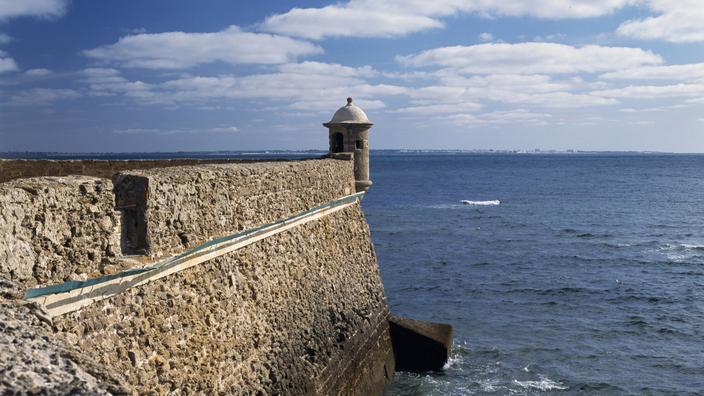Lidar has struck again.
Airborne laser scanner remote sensing technology, to which we owe many shattering discoveries, from Mayan temples to Khmer cities, could have identified, near Cadiz (Spain) the outline of a structure sought for years by archaeologists. .
This is the Punic sanctuary of Melqart, transformed in Roman times into a space dedicated to the cult of Hercules Gaditanus, named after the ancient port of Gades - present-day Cadiz.
Either one of the major temples of the ancient Iberian Peninsula.
Read alsoA maritime villa and Roman baths unearthed on the beaches of Trafalgar
Presented on December 15 by a team of archaeologists from the University of Seville and the Andalusian Institute of Historical Heritage (IAPH), the monumental structure was discovered between the locality of Camposoto and that of Sancti Petri, to the south from Cadiz. In the meanders of this swampy section of the Atlantic coast, the lidar spotted the silhouette of a rectangular enclosure enclosing an area of approximately 4.5 hectares. The profile of a sanctuary, formerly located on an islet of which it occupied the entire surface. But since then, the tongue of land below 3 to 5 meters below sea level. This presence was confirmed during a preliminary inspection of the site, carried out at low tide, which made it possible to identify the presence of remains, in particular of freestone blocks.
The layout of the sanctuary of Melqart and Hercules Gaditanus (in the center), discovered not far from Cadiz (Spain). University of Sevilla
While waiting for a future geophysical prospecting supposed to confirm the trace on the ground of the vestiges then, if all goes well, the beginning of the excavations strictly speaking, the Spanish archaeologists are exulting. The object of a long quarrel between specialists, the precise situation of the sanctuary of Melqart then of Hercules has long escaped scientists because of the very fragmented landscape of the region, between sea and land. As well as by the comings and goings of the tide. Difficult indeed, for researchers, to find the temple of Hercules in the domain of Neptune.
"These are areas where it is difficult to work and where visibility is poor"
, readily clarified for the Spanish daily
El País.
Milagros Alzaga, head of the IAPH Center for Underwater Archeology.
According to the specialist, the environmental conditions and the strong current of water will not allow working in good conditions for more than three hours on site.
Read alsoA 12th-century Almohad hammam discovered in a tapas bar in Seville
A highly anthropized coastline
This environment hostile to prospecting has thus revealed itself in a new light thanks to lidar.
In addition to the coveted sanctuary, a whole section of the ancient coastline has emerged from the images captured by laser.
Processed by free software, they have enabled Spanish archaeologists to see the outlines of many hitherto unsuspected remains emerge before their eyes.
Unbeknownst to them, the researchers were thus circling around a
"coastline heavily anthropized since Antiquity, punctuated by possible breakwaters, large buildings and even a possible closed harbor dock"
, in the words of a press release from the University of Seville.
Read alsoA sumptuous Roman mansion, in the heart of a rich property, resurfaces in Andalusia
Consecrated at least since the 9th century BC. AD, the original Punic sanctuary was dedicated to the cult of the Phoenician god Melqart. The cult complex had been erected on the southern outskirts of Gades' trading post. In contact with the Greeks, the cult is associated with that of the demigod Heracles, an association that the Romans will take over under the name of Hercules Gaditanus. Very popular, the sanctuary consisted of an enclosed sacred space, a temple and several annex buildings. Two monumental columns placed at the entrance of the complex evoked, according to ancient texts cited by archaeologists from the University of Seville, the Columns of Hercules, name given to the mountains flanking the Strait of Gibraltar, some 80 kilometers from Cadiz.
Visited by the Punic General Hannibal as well as by Julius Caesar, the sanctuary was also referenced with pride on the coins of the reign of the Emperors Trajan and Hadrian, with Hispanic origins. A memory such that it continues to work the imagination of Spaniards steeped in historical sciences.
"This is not just any excavation, it is in the DNA of Andalusian and Western culture"
, trumpeted to the regional daily
Diario de Cádiz.
, the director of the Department of Prehistory of the University of Seville, Francisco José García.
An enthusiasm tempered by the researchers involved in this file, who are now responsible for preparing a particularly complex excavation campaign.
Long-term work, in perspective.
Their twelve archaeological works.











/cloudfront-eu-central-1.images.arcpublishing.com/prisa/KMEYMJKESBAZBE4MRBAM4TGHIQ.jpg)


